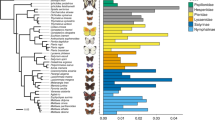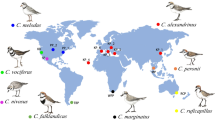Abstract
Small isolated populations are frequently genetically less diverse than core populations, resulting in higher homozygosity that can hamper their long-term survival1,2,3,4. The decrease in fitness of organisms owing to matings between relatives is well known from captive and laboratory animals. Such inbreeding can have strongly deleterious effects on life-history traits and survival5,6,7,8,9,10,11, and can be critical to the success of population conservation2,4,12. Because pedigrees are hard to follow in the wild, most field studies have used marker loci to establish that fitness declines with increasing homozygosity1,13,14. Very few have experimentally explored the effects of inbreeding in the wild15, or compared observations in the laboratory with field conditions8,9. Here, using a technique involving the transfer of marker dusts during copulation, we show that a small decrease in mating success of captive inbred male butterflies in cages is greatly accentuated in conditions with unconstrained flight. Our results have important implications for conservation and for studies of sexual selection because they show that the behaviours underlying patterns of mating can be profoundly influenced by a history of inbreeding or by any restraining experimental conditions.
This is a preview of subscription content, access via your institution
Access options
Subscribe to this journal
Receive 51 print issues and online access
$199.00 per year
only $3.90 per issue
Buy this article
- Purchase on Springer Link
- Instant access to full article PDF
Prices may be subject to local taxes which are calculated during checkout


Similar content being viewed by others
References
Keller, L. F. & Waller, D. M. Inbreeding effects in the wild. Trends Ecol. Evol. 17, 230–241 (2002)
Saccheri, I. et al. Inbreeding and extinction in a butterfly metapopulation. Nature 392, 491–494 (1998)
Bijlsma, R., Bundgaard, J. & Boerema, A. C. Does inbreeding affect the extinction risk of small populations? Predictions from Drosophila. J. Evol. Biol. 13, 502–514 (2000)
Keller, L. F., Arcese, P., Smith, J. N. M., Hochachka, W. M. & Stearns, S. C. Selection against inbred song sparrows during a natural population bottleneck. Nature 372, 356–357 (1994)
Roff, D. A. & DeRose, M. A. The evolution of trade-offs: Effects of inbreeding on fecundity relationships in the cricket Gryllus firmus. Evolution 55, 111–121 (2001)
Saccheri, I., Brakefield, P. M. & Nichols, R. A. Severe inbreeding depression and rapid fitness rebound in the butterfly Bicyclus anynana (Satyridae). Evolution 50, 2000–2013 (1996)
DeRose, M. A. & Roff, D. A. A comparison of inbreeding depression in life-history and morphological traits in animals. Evolution 53, 1288–1292 (1999)
Armbruster, P., Hutchinson, R. A. & Linvell, T. Equivalent inbreeding depression under laboratory and field conditions in a tree-hole-breeding mosquito. Proc. R. Soc. Lond. B 267, 1939–1945 (2000)
Meagher, S., Penn, D. J. & Potts, W. K. Male–male competition magnifies inbreeding depression in wild house mice. Proc. Natl Acad. Sci. USA 97, 3324–3329 (2000)
van Oosterhout, C., Zijlstra, W. G., van Heuven, M. K. & Brakefield, P. M. Inbreeding depression and genetic load in laboratory metapopulations of the butterfly Bicyclus anynana. Evolution 54, 218–225 (2000)
Nieminen, M., Singer, M. C., Fortelius, W., Schöps, K. & Hanski, I. Experimental confirmation that inbreeding depression increases extinction risk in butterfly populations. Am. Nat. 157, 237–244 (2001)
Madsen, T., Shine, R., Olsson, M. & Wittzell, H. Restoration of an inbred adder population. Nature 402, 34–35 (1999)
Coulson, T. N. et al. Genotype by environment interactions in winter survival in red deer. J. Anim. Ecol. 67, 434–445 (1998)
Höglund, J. et al. Inbreeding depression and male fitness in black grouse. Proc. R. Soc. Lond. B 269, 711–715 (2002)
Jimenez, J. A., Hughes, K. A., Alaks, G., Graham, L. & Lacy, R. C. An experimental study of inbreeding depression in a natural habitat. Science 266, 271–273 (1994)
Miller, P. S., Glasner, J. & Hedrick, P. W. Inbreeding depression and male-mating behavior in Drosophila melanogaster. Genetica 88, 29–36 (1993)
Meffert, L. M. & Bryant, E. H. Mating propensity and courtship behavior in serially bottlenecked lines of the housefly. Evolution 45, 293–306 (1991)
Maynard Smith, J. Fertility, mating behaviour, and sexual selection in Drosophila subobscura. J. Genet. 54, 261–279 (1956)
Breuker, C. J. & Brakefield, P. M. Female choice depends on size but not symmetry of dorsal eyespots in the butterfly Bicyclus anynana. Proc. R. Soc. Lond. B 269, 1233–1239 (2002)
Brakefield, P. M. & Reitsma, N. Phenotypic plasticity, seasonal climate and the population biology of Bicyclus butterflies (Satyridae) in Malawi. Ecol. Entomol. 16, 291–303 (1991)
Saccheri, I. & Brakefield, P. M. Rapid spread of immigrant genomes into inbred populations. Proc. R. Soc. Lond. B 269, 1073–1078 (2002)
Ebert, D. et al. A selective advantage to immigrant genes in a Daphnia metapopulation. Science 295, 485–488 (2002)
Marr, A. B., Keller, L. F. & Arcese, P. Heterosis and outbreeding depression in descendants of natural immigrants to an inbred population of song sparrows (Melospiza melodia). Evolution 56, 131–142 (2002)
Hanski, I. & Gilpin, M. Metapopulation Biology: Ecology, Genetics and Evolution (Academic, London, 1996)
Hedrick, P. W. & Kalinowski, S. T. Inbreeding depression in conservation biology. Annu. Rev. Ecol. Syst. 31, 139–162 (2000)
Miller, P. S. & Hedrick, P. W. Inbreeding and fitness in captive populations—lessons from Drosophila. Zoo Biol. 12, 333–351 (1993)
Tregenza, T. & Wedell, N. Polyandrous females avoid the costs of inbreeding. Nature 415, 71–73 (2002)
Brakefield, P. M. et al. Effective population size, reproductive success and sperm precedence in the butterfly Bicyclus anynana in captivity. J. Evol. Biol. 14, 148–156 (2001)
Sokal, R. R. & Rohlf, F. J. Biometry. The Principles and Practice of Statistics in Biological Research (W. H. Freeman, New York, 1995)
Lynch, M. & Walsh, B. Genetics and Analysis of Quantitative Traits (Sinauer, Sunderland, Massachusetts, 1998)
Acknowledgements
We thank I. Saccheri, B. Zwaan and C. Breuker for help with the experimental design and preliminary experiments, M. Begon for providing fluorescent dusts, and N. Wurzer and M. Lavrijsen for technical help and host-plant cultivation. We are grateful to the Hortus Botanicus Leiden for access to the greenhouse. Finance and support was provided by the European Union TMR Network ‘Survival of Species in Fragmented Landscapes’ (FRAGLAND).
Author information
Authors and Affiliations
Corresponding authors
Ethics declarations
Competing interests
The authors declare that they have no competing financial interests.
Supplementary information
Rights and permissions
About this article
Cite this article
Joron, M., Brakefield, P. Captivity masks inbreeding effects on male mating success in butterflies. Nature 424, 191–194 (2003). https://doi.org/10.1038/nature01713
Received:
Accepted:
Issue Date:
DOI: https://doi.org/10.1038/nature01713
This article is cited by
-
Patterns of Performance Variation Between Animal Hybrids and their Parents: A Meta-analysis
Evolutionary Biology (2022)
-
Genetic monitoring of the greater stick-nest rat meta-population for strategic supplementation planning
Conservation Genetics (2020)
-
Sexual selection contributes to partial restoration of phenotypic robustness in a butterfly
Scientific Reports (2018)
-
Inbreeding depression by environment interactions in a free-living mammal population
Heredity (2017)
-
Laboratory social environment biases mating outcome: a first quantitative synthesis in a butterfly
Behavioral Ecology and Sociobiology (2017)
Comments
By submitting a comment you agree to abide by our Terms and Community Guidelines. If you find something abusive or that does not comply with our terms or guidelines please flag it as inappropriate.



